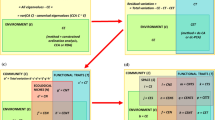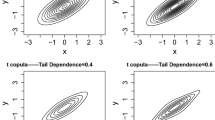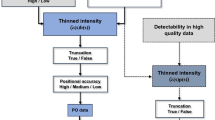Abstract
For quantifying m-dimensional (\(m \ge 3\)) niche regions and niche overlaps using a copula-based approach, commonly used copulas, including Archimedean and elliptical copula families, are unsatisfactory alternatives in characterizing a complex dependence structure among multiple variables, especially when bi-variate copulas characterizing dependency structures of two-dimensional sub-variables differ. To solve the problem, we improve the copula-based niche space modeling approach using simplified vine copulas, a powerful tool containing various bi-variate dependence structures in one multivariate copula. Using four simulated data sets, we then check the performance of simplified vine copula approximation when the simplifying assumption is invalid. Finally, we apply the improved copula-based approach to quantifying a three-dimensional niche space of a real case of Swanson et al. (Ecology 96(2):318–324, 2015. https://doi.org/10.1890/14-0235.1) and discover that among various simplified vine and other flexible multi-dimensional copulas, non-parametric simplified vine copula approximation performs best in fitting the data set. In the discussion, to analyze differences in calculating niche overlaps caused by using different copulas, we compare non-parametric simplified vine copula approximation with non-parametric and parametric simplified vine copula approximation, elliptical copula, Hierarchical Archimedean copula estimation, and empirical beta copula and give some comments on the results.








Similar content being viewed by others
Notes
The normalized bi-variate contour plot is a good way of showcasing the dependence of bi-variate copulas by transforming copula margins from uniform into standard normal distributions. Hence, the plot does not represent the contour plot of a copula density.
References
Bearhop S, Adams CE, Waldron S et al (2004) Determining trophic niche width: a novel approach using stable isotope analysis. J Anim Ecol 73(5):1007–1012. https://doi.org/10.1111/j.0021-8790.2004.00861.x
Bedford T, Cooke RM (2001) Probability density decomposition for conditionally dependent random variables modeled by vines. Ann Math Artif Intell 32:245–268. https://doi.org/10.1023/A:1016725902970
Bedford T, Cooke RM (2002) Vines—a new graphical model for dependent random variables. Ann Stat 30(4):1031–1068. https://doi.org/10.1214/aos/1031689016
Chase JM, Leibold MA (2009) Ecological niches: linking classical and contemporary approaches. University of Chicago Press, Chicago
Czado C (2019) Analyzing dependent data with vine copulas. Springer, Cham
Elton CS (2001) Animal ecology. University of Chicago Press, Chicago
Flanders WD, Strickland MJ, Klein M (2015) A new method for partial correction of residual confounding in time-series and other observational studies. ar**v:1510.06905
Grinnell J (1917) The niche-relationships of the California thrasher. Auk 34(4):427–433. https://doi.org/10.2307/4072271
Guzzo MM, Haffner GD, Legler ND et al (2013) Fifty years later: trophic ecology and niche overlap of a native and non-indigenous fish species in the Western Basin of Lake Erie. Biol Invasions 15:1695–1711. https://doi.org/10.1007/s10530-012-0401-z
Huang S, Zhou Q, Gu L et al (2020) Modeling and simulation study of the stoichiometric niche space and niche overlap based on the copula method. Environ Ecol Stat 27:115–149. https://doi.org/10.1007/s10651-019-00437-0
Hutchinson GE (1957) Concluding remarks. In: Paper presented at the Cold Spring Harbor symposia on quantitative biology. https://doi.org/10.1101/SQB.1957.022.01.039
Jackson AL, Inger R, Parnell AC et al (2011) Comparing isotopic niche widths among and within communities: Siber-stable isotope Bayesian ellipses in R. J Anim Ecol 80(3):595–602. https://doi.org/10.1111/j.1365-2656.2011.01806.x
Jackson MC, Donohue I, Jackson AL et al (2012) Population-level metrics of trophic structure based on stable isotopes and their application to invasion ecology. PLoS ONE 7(2):e31757. https://doi.org/10.1371/journal.pone.0031757
Joe H (1997) Multivariate models and dependence concepts. Chapman and Hall, London
Kauermann G, Schellhase C (2014) Flexible pair-copula estimation in D-vines using bivariate penalized splines. Stat Comput 24:1081–1100
Layman CA, Arrington DA, Montaña CG et al (2007) Can stable isotope ratios provide for community-wide measures of trophic structure? Ecology 88(1):42–48. https://doi.org/10.1890/0012-9658(2007)88[42:CSIRPF]2.0.CO;2
Leibold MA (1995) The niche concept revisited: mechanistic models and community context. Ecology 76(5):1371–1382. https://doi.org/10.2307/1938141
May RM (1974) On the theory of niche overlap. Theor Popul Biol 5(3):297–332. https://doi.org/10.1016/0040-5809(74)90055-0
Mroz T, Fuchs S, Trutschnig W (2021) How simplifying and flexible is the simplifying assumption in pair-copula constructions—analytic answers in dimension three and a glimpse beyond. Electron J Stat 15(1):1951–1992. https://doi.org/10.1214/21-EJS1832
Nagler T, Czado C (2016) Evading the curse of dimensionality in nonparametric density estimation with simplified vine copulas. J Multivar Anal 151:69–89. https://doi.org/10.1016/j.jmva.2016.07.003
Nagler T, Schellhase C, Czado C (2017) Nonparametric estimation of simplified vine copula models: comparison of methods. Depend Model 5(1):99–120. https://doi.org/10.1515/demo-2017-0007
Nelsen RB (2006) An introduction to copulas. Springer, New York
Newsome SD, Martinez del Rio C, Bearhop S et al (2007) A niche for isotopic ecology. Front Ecol Environment 5(8):429–436. https://doi.org/10.1890/060150.1
Núñez-Antonio G, Mendoza M, Contreras-Cristán A et al (2018) Bayesian nonparametric inference for the overlap of daily animal activity patterns. Environ Ecol Stat 25:471–494. https://doi.org/10.1007/s10651-018-0414-6
Scheffer M, Wei GNF (2017) Smooth nonparametric Bernstein vine copulas. Quant Finance 17(1):139–156. https://doi.org/10.1080/14697688.2016.1185141
Spanhel F, Kurz MS (2019) Simplified vine copula models: approximations based on the simplifying assumption. Electron J Stat 13(1):1254–1291. https://doi.org/10.1214/19-EJS1547
Swanson HK, Lysy M, Power M et al (2015) A new probabilistic method for quantifying n-dimensional ecological niches and niche overlap. Ecology 96(2):318–324. https://doi.org/10.1890/14-0235.1
Uyttendaele N (2014) Nested Archimedean copulas: a new class of nonparametric tree structure estimators. ar**v:1407.0230
Author information
Authors and Affiliations
Corresponding author
Ethics declarations
Conflict of interest
The authors declare that they have no known competing financial interests or personal relationships that could have appeared to influence the work reported in this paper.
Additional information
Handling Editor: Luiz Duczmal.
Rights and permissions
Springer Nature or its licensor (e.g. a society or other partner) holds exclusive rights to this article under a publishing agreement with the author(s) or other rightsholder(s); author self-archiving of the accepted manuscript version of this article is solely governed by the terms of such publishing agreement and applicable law.
About this article
Cite this article
Zhou, Q., Huang, S. A simplified vine copula-based probabilistic method for quantifying multi-dimensional ecological niches and niche overlap: take a three-dimensional case as an example. Environ Ecol Stat (2024). https://doi.org/10.1007/s10651-024-00622-w
Received:
Revised:
Accepted:
Published:
DOI: https://doi.org/10.1007/s10651-024-00622-w










